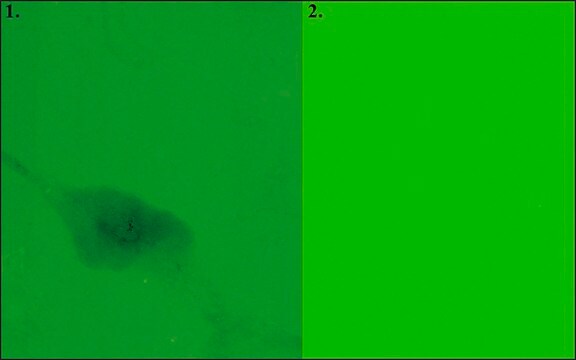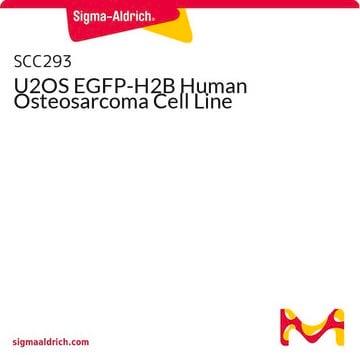CLL1218
U2OS LMNB1-TUBA1B-ACTB
human female bone (Disease source: Osteosarcoma)
Sign Into View Organizational & Contract Pricing
All Photos(5)
About This Item
UNSPSC Code:
41106514
NACRES:
NA.81
Recommended Products
product name
U2OS LMNB1-TUBA1B-ACTB,
biological source
human female bone (Source Disease: Osteosarcoma)
storage temp.
−196°C
Gene Information
human ... ACTB(60) , LMNB1(4001) , TUBA1B(10376)
General description
U2OS LMNB1-TUBA1B-ACTB are bone osteosarcoma cells from a human 15 year old caucasion female having three distinct ZFN modifications creating a BFP-tagged LMNB1 transgene, a GFP-tagged TUBA1B transgene and a RFP-tagged ACTB transgene expressed from their endogenous gene locus.
This cell line was derived from ATCC Catalog No. HTB-96.
This cell line was derived from ATCC Catalog No. HTB-96.
Application
This product is a human U2OS cell line in which three genomic loci - LMNB1, TUBA1B, and ACTB - have been endogenously tagged with fluorescent protein genes for Blue Fluorescent Protein (BFP), Green Fluorescent Protein (GFP), and Red Fluorescent Protein (RFP), respectively, using CompoZr® zinc finger nuclease (ZFN) technology. Integration resulted in endogenous expression of: 1) the fluorescent fusion protein, BFP-laminB1, easily detected in the nuclear envelope; 2) the fluorescent fusion protein, GFP-α-tubulin, that polymerizes to form characteristic patterns of microtubules; 3) the fluorescent fusion protein, RFP-β-actin, that polymerizes to form characteristic patterns of actin fibers. Imaging of the cell line shows fluorescent labeling of the three proteins having normal cellular distribution patterns which makes the cell line ideal for high content screening to identify compounds that modulate cellular activity. This stable cell line was expanded from a single cell clone. The LMNB1, TUBA1B, and ACTB gene regulation and corresponding protein function are preserved in contrast to cell lines exhibiting overexpression from an exogenous promoter.
To learn more, please visit the Cellular Reporter Cell Line webpage
Biochem/physiol Actions
Nuclear lamin B1, encoded by the LMNB1 gene, is an intermediate filament protein of the nuclear envelope. The protein exhibits transcriptional co-regulatory activity and plays a key role in DNA replication, cellular aging and stress responses. Thus, LMNB1 can be used as a potential biomarker for HCC.
Tubulin α 1b (TUBA1B) is a microtubule protein, which plays a vital role in dynamic process of polymerization and depolymerization during cell replication and division. TUBA1B is overexpressed in hepatocellular carcinoma (HCC) tumor tissues and proliferating HCC cells. This upregulated expression of the gene leads to poor prognosis and chemotherapy resistance in HCC.
Actin β (ACTB) is an abundant cytoskeletal housekeeping protein. The protein is expressed in the nucleus and controls gene expression, cell division and proliferation. ACTB is generally used as a reference gene in measuring expression levels in tumors.
Tubulin α 1b (TUBA1B) is a microtubule protein, which plays a vital role in dynamic process of polymerization and depolymerization during cell replication and division. TUBA1B is overexpressed in hepatocellular carcinoma (HCC) tumor tissues and proliferating HCC cells. This upregulated expression of the gene leads to poor prognosis and chemotherapy resistance in HCC.
Actin β (ACTB) is an abundant cytoskeletal housekeeping protein. The protein is expressed in the nucleus and controls gene expression, cell division and proliferation. ACTB is generally used as a reference gene in measuring expression levels in tumors.
Features and Benefits
Zinc Finger Nuclease (ZFN)-mediated targeted integration of three different fluorescent tags: LMNB1 is BFP-tagged on chromosome 5q23.2-q31.1, TUBA1B is GFP-tagged on chromosome 12q13.12 and ACTB is RFP-tagged on chromosome 7p22.1 to create a cell line exhibiting stable expression of all three transgenes.
The U2OS cells are adherent, with a doubling time of approx. 29 hours.
The U2OS cells are adherent, with a doubling time of approx. 29 hours.
Quality
Tested for Mycoplasma, sterility, post-freeze viability, short terminal repeat (STR) analysis for cell line identification, cytochrome oxidase I (COI) analysis for cell line species confirmation.
Preparation Note
Media Renewal changes two to three times per week.
Rapidly thaw vial by gentle agitation in 37°C water bath (~2 minutes), keeping vial cap out of the water. Decontaminate with 70% ethanol, add 9 mL culture media and centrifuge 125 x g (5-7 minutes). Resuspend in complete culture media and incubate at 37°C in a 5% CO2 atmosphere.
Subculture Ratio: approx. 1:3-1:6
The base medium for this cell line is McCoy′s 5A Medium Modified, Cat. No. M9309. To make the complete growth medium, add the following components to the base medium: fetal bovine serum, Cat. No. F4135, to a final concentration (v/v) of 10%.
Cell freezing medium-DMSO 1X, Cat. No. C6164.
Rapidly thaw vial by gentle agitation in 37°C water bath (~2 minutes), keeping vial cap out of the water. Decontaminate with 70% ethanol, add 9 mL culture media and centrifuge 125 x g (5-7 minutes). Resuspend in complete culture media and incubate at 37°C in a 5% CO2 atmosphere.
Subculture Ratio: approx. 1:3-1:6
The base medium for this cell line is McCoy′s 5A Medium Modified, Cat. No. M9309. To make the complete growth medium, add the following components to the base medium: fetal bovine serum, Cat. No. F4135, to a final concentration (v/v) of 10%.
Cell freezing medium-DMSO 1X, Cat. No. C6164.
Legal Information
CompoZr is a registered trademark of Merck KGaA, Darmstadt, Germany
Disclaimer
RESEARCH USE ONLY. This product is regulated in France when intended to be used for scientific purposes, including for import and export activities (Article L 1211-1 paragraph 2 of the Public Health Code). The purchaser (i.e. enduser) is required to obtain an import authorization from the France Ministry of Research referred in the Article L1245-5-1 II. of Public Health Code. By ordering this product, you are confirming that you have obtained the proper import authorization.
Storage Class Code
10 - Combustible liquids
WGK
WGK 3
Flash Point(F)
Not applicable
Flash Point(C)
Not applicable
Certificates of Analysis (COA)
Search for Certificates of Analysis (COA) by entering the products Lot/Batch Number. Lot and Batch Numbers can be found on a product’s label following the words ‘Lot’ or ‘Batch’.
Already Own This Product?
Find documentation for the products that you have recently purchased in the Document Library.
Barney Boyce et al.
Scientific reports, 8(1), 14755-14755 (2018-10-05)
As an alternative to laser-based methods, we developed a novel in situ cell isolation method and instrument based on local water absorption of millimeter wave (MMW) radiation that occurs in cellular material and nearby culture medium while the cultureware materials
Circulating Lamin B1 (LMNB1) Biomarker Detects Early Stages of Liver Cancer in Patients
Sun S, et al.
Journal of Proteome Research, 9(1), 70-78 (2009)
Structural Organization of the Human Gene (LMNB1) Encoding Nuclear Lamin B1
Lin F, et al.
Genomics, 27(2), 230-236 (1995)
ACTB in cancer.
Guo C, et al.
Clinica Chimica Acta; International Journal of Clinical Chemistry, 417, 39-44 (2013)
Up-regulation of TUBA1B promotes astrocyte proliferation after spinal cord injury in adult rats.
Liu Y, et al.
International Journal of Clinical and Experimental Pathology, 10(2), 1094-1103 (2017)
Our team of scientists has experience in all areas of research including Life Science, Material Science, Chemical Synthesis, Chromatography, Analytical and many others.
Contact Technical Service






